Financial Accounting Report: Analysis of Impairment Testing Procedures
VerifiedAdded on 2020/05/16
|6
|1496
|473
Report
AI Summary
This report provides an in-depth analysis of impairment testing procedures, focusing on the practices of Jetset Travel World Ltd. It examines the assets subject to impairment, including goodwill, franchisee systems, and brand names. The report details the impairment testing procedure, including the allocation of goodwill to cash-generating units and the recognition of impairment expenditures. Key estimates and assumptions used in the process, such as cash flow forecasts and discount rates, are also discussed. The report highlights the subjectivity involved in impairment testing, particularly in the allocation of intangibles and the estimation of recoverable amounts. It explores the process of fair value measurement and provides insights into the new developments in impairment procedures, including qualitative testing. The analysis is supported by references to accounting standards and relevant literature.

Advance financial accounting
Paraphrase This Document
Need a fresh take? Get an instant paraphrase of this document with our AI Paraphraser
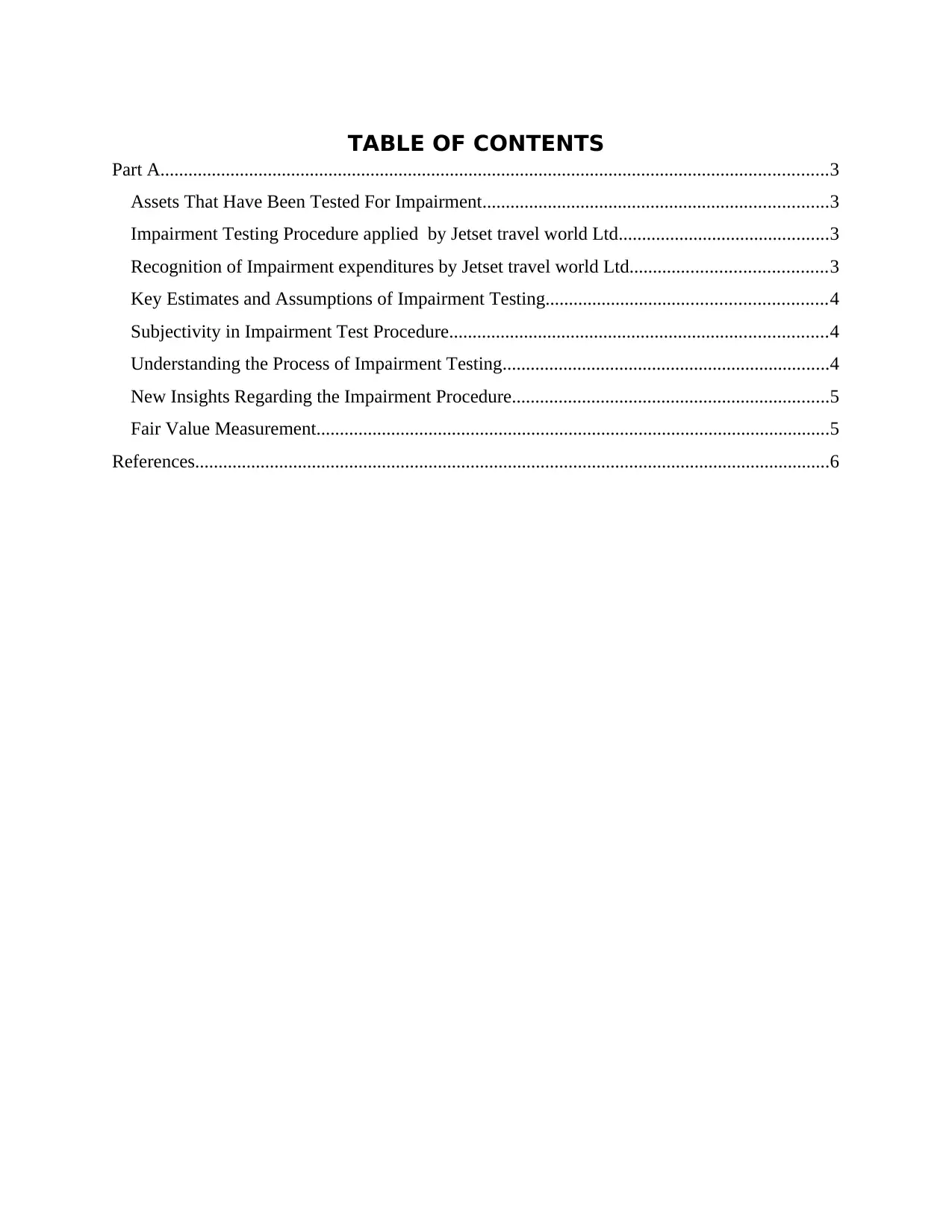
TABLE OF CONTENTS
Part A...............................................................................................................................................3
Assets That Have Been Tested For Impairment..........................................................................3
Impairment Testing Procedure applied by Jetset travel world Ltd.............................................3
Recognition of Impairment expenditures by Jetset travel world Ltd..........................................3
Key Estimates and Assumptions of Impairment Testing............................................................4
Subjectivity in Impairment Test Procedure.................................................................................4
Understanding the Process of Impairment Testing......................................................................4
New Insights Regarding the Impairment Procedure....................................................................5
Fair Value Measurement..............................................................................................................5
References........................................................................................................................................6
Part A...............................................................................................................................................3
Assets That Have Been Tested For Impairment..........................................................................3
Impairment Testing Procedure applied by Jetset travel world Ltd.............................................3
Recognition of Impairment expenditures by Jetset travel world Ltd..........................................3
Key Estimates and Assumptions of Impairment Testing............................................................4
Subjectivity in Impairment Test Procedure.................................................................................4
Understanding the Process of Impairment Testing......................................................................4
New Insights Regarding the Impairment Procedure....................................................................5
Fair Value Measurement..............................................................................................................5
References........................................................................................................................................6
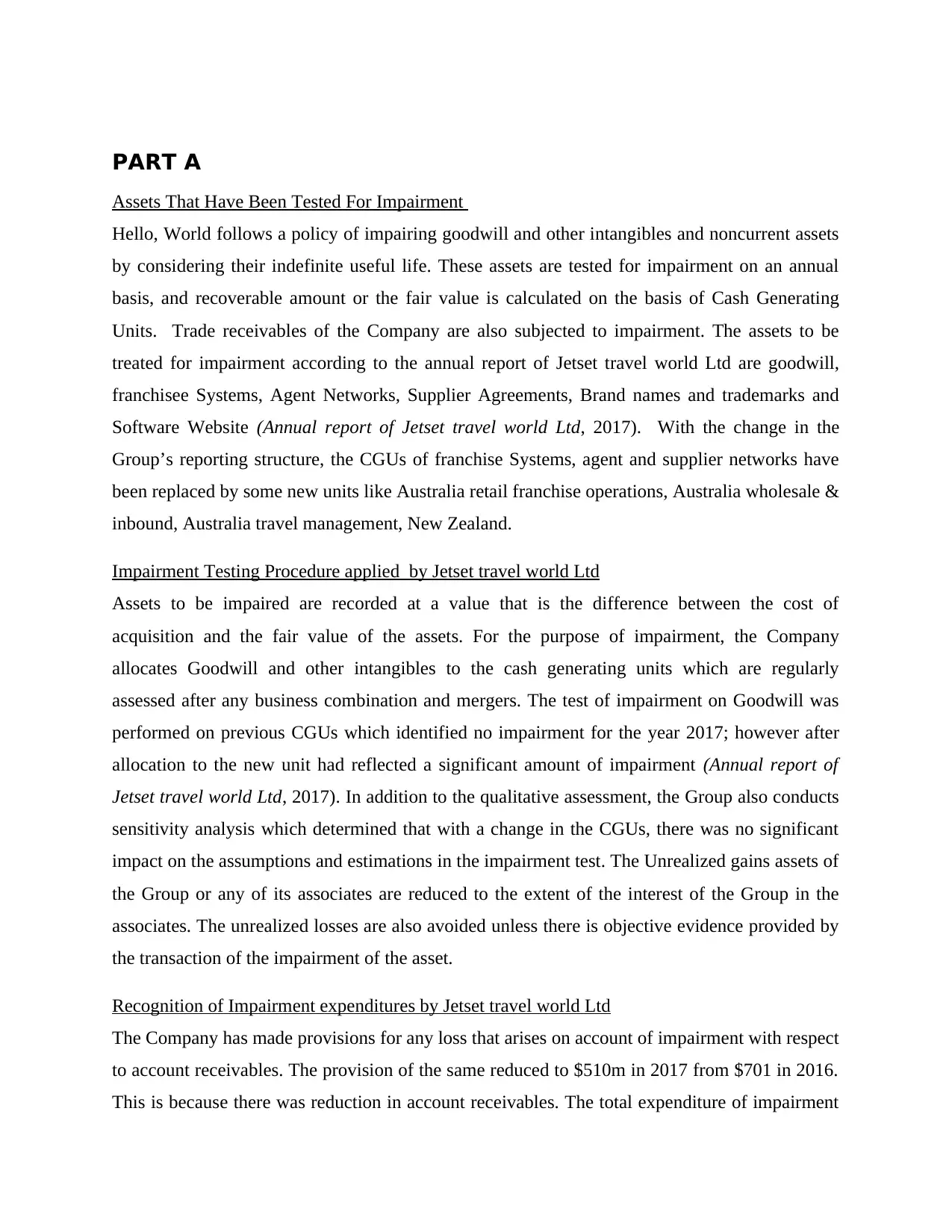
PART A
Assets That Have Been Tested For Impairment
Hello, World follows a policy of impairing goodwill and other intangibles and noncurrent assets
by considering their indefinite useful life. These assets are tested for impairment on an annual
basis, and recoverable amount or the fair value is calculated on the basis of Cash Generating
Units. Trade receivables of the Company are also subjected to impairment. The assets to be
treated for impairment according to the annual report of Jetset travel world Ltd are goodwill,
franchisee Systems, Agent Networks, Supplier Agreements, Brand names and trademarks and
Software Website (Annual report of Jetset travel world Ltd, 2017). With the change in the
Group’s reporting structure, the CGUs of franchise Systems, agent and supplier networks have
been replaced by some new units like Australia retail franchise operations, Australia wholesale &
inbound, Australia travel management, New Zealand.
Impairment Testing Procedure applied by Jetset travel world Ltd
Assets to be impaired are recorded at a value that is the difference between the cost of
acquisition and the fair value of the assets. For the purpose of impairment, the Company
allocates Goodwill and other intangibles to the cash generating units which are regularly
assessed after any business combination and mergers. The test of impairment on Goodwill was
performed on previous CGUs which identified no impairment for the year 2017; however after
allocation to the new unit had reflected a significant amount of impairment (Annual report of
Jetset travel world Ltd, 2017). In addition to the qualitative assessment, the Group also conducts
sensitivity analysis which determined that with a change in the CGUs, there was no significant
impact on the assumptions and estimations in the impairment test. The Unrealized gains assets of
the Group or any of its associates are reduced to the extent of the interest of the Group in the
associates. The unrealized losses are also avoided unless there is objective evidence provided by
the transaction of the impairment of the asset.
Recognition of Impairment expenditures by Jetset travel world Ltd
The Company has made provisions for any loss that arises on account of impairment with respect
to account receivables. The provision of the same reduced to $510m in 2017 from $701 in 2016.
This is because there was reduction in account receivables. The total expenditure of impairment
Assets That Have Been Tested For Impairment
Hello, World follows a policy of impairing goodwill and other intangibles and noncurrent assets
by considering their indefinite useful life. These assets are tested for impairment on an annual
basis, and recoverable amount or the fair value is calculated on the basis of Cash Generating
Units. Trade receivables of the Company are also subjected to impairment. The assets to be
treated for impairment according to the annual report of Jetset travel world Ltd are goodwill,
franchisee Systems, Agent Networks, Supplier Agreements, Brand names and trademarks and
Software Website (Annual report of Jetset travel world Ltd, 2017). With the change in the
Group’s reporting structure, the CGUs of franchise Systems, agent and supplier networks have
been replaced by some new units like Australia retail franchise operations, Australia wholesale &
inbound, Australia travel management, New Zealand.
Impairment Testing Procedure applied by Jetset travel world Ltd
Assets to be impaired are recorded at a value that is the difference between the cost of
acquisition and the fair value of the assets. For the purpose of impairment, the Company
allocates Goodwill and other intangibles to the cash generating units which are regularly
assessed after any business combination and mergers. The test of impairment on Goodwill was
performed on previous CGUs which identified no impairment for the year 2017; however after
allocation to the new unit had reflected a significant amount of impairment (Annual report of
Jetset travel world Ltd, 2017). In addition to the qualitative assessment, the Group also conducts
sensitivity analysis which determined that with a change in the CGUs, there was no significant
impact on the assumptions and estimations in the impairment test. The Unrealized gains assets of
the Group or any of its associates are reduced to the extent of the interest of the Group in the
associates. The unrealized losses are also avoided unless there is objective evidence provided by
the transaction of the impairment of the asset.
Recognition of Impairment expenditures by Jetset travel world Ltd
The Company has made provisions for any loss that arises on account of impairment with respect
to account receivables. The provision of the same reduced to $510m in 2017 from $701 in 2016.
This is because there was reduction in account receivables. The total expenditure of impairment
⊘ This is a preview!⊘
Do you want full access?
Subscribe today to unlock all pages.

Trusted by 1+ million students worldwide
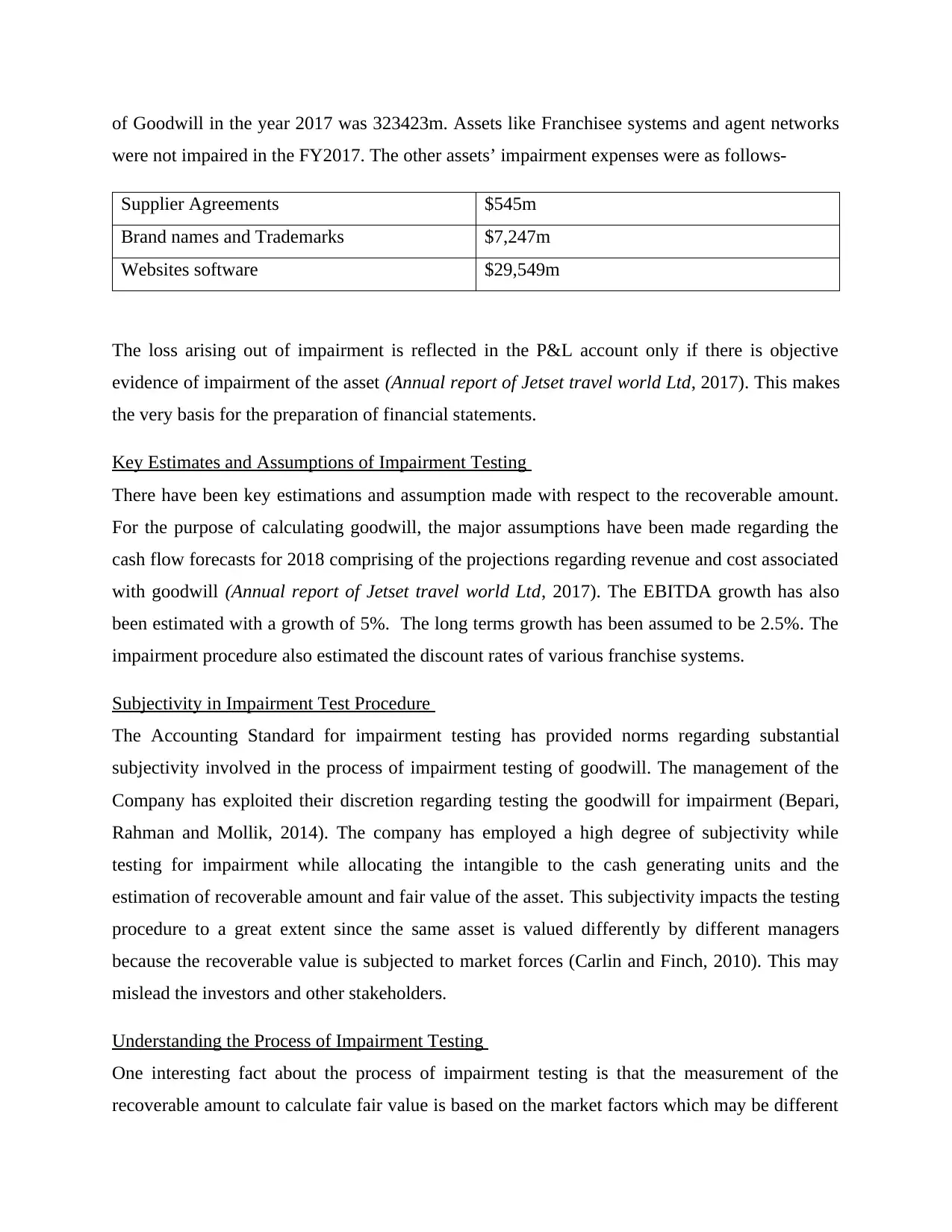
of Goodwill in the year 2017 was 323423m. Assets like Franchisee systems and agent networks
were not impaired in the FY2017. The other assets’ impairment expenses were as follows-
Supplier Agreements $545m
Brand names and Trademarks $7,247m
Websites software $29,549m
The loss arising out of impairment is reflected in the P&L account only if there is objective
evidence of impairment of the asset (Annual report of Jetset travel world Ltd, 2017). This makes
the very basis for the preparation of financial statements.
Key Estimates and Assumptions of Impairment Testing
There have been key estimations and assumption made with respect to the recoverable amount.
For the purpose of calculating goodwill, the major assumptions have been made regarding the
cash flow forecasts for 2018 comprising of the projections regarding revenue and cost associated
with goodwill (Annual report of Jetset travel world Ltd, 2017). The EBITDA growth has also
been estimated with a growth of 5%. The long terms growth has been assumed to be 2.5%. The
impairment procedure also estimated the discount rates of various franchise systems.
Subjectivity in Impairment Test Procedure
The Accounting Standard for impairment testing has provided norms regarding substantial
subjectivity involved in the process of impairment testing of goodwill. The management of the
Company has exploited their discretion regarding testing the goodwill for impairment (Bepari,
Rahman and Mollik, 2014). The company has employed a high degree of subjectivity while
testing for impairment while allocating the intangible to the cash generating units and the
estimation of recoverable amount and fair value of the asset. This subjectivity impacts the testing
procedure to a great extent since the same asset is valued differently by different managers
because the recoverable value is subjected to market forces (Carlin and Finch, 2010). This may
mislead the investors and other stakeholders.
Understanding the Process of Impairment Testing
One interesting fact about the process of impairment testing is that the measurement of the
recoverable amount to calculate fair value is based on the market factors which may be different
were not impaired in the FY2017. The other assets’ impairment expenses were as follows-
Supplier Agreements $545m
Brand names and Trademarks $7,247m
Websites software $29,549m
The loss arising out of impairment is reflected in the P&L account only if there is objective
evidence of impairment of the asset (Annual report of Jetset travel world Ltd, 2017). This makes
the very basis for the preparation of financial statements.
Key Estimates and Assumptions of Impairment Testing
There have been key estimations and assumption made with respect to the recoverable amount.
For the purpose of calculating goodwill, the major assumptions have been made regarding the
cash flow forecasts for 2018 comprising of the projections regarding revenue and cost associated
with goodwill (Annual report of Jetset travel world Ltd, 2017). The EBITDA growth has also
been estimated with a growth of 5%. The long terms growth has been assumed to be 2.5%. The
impairment procedure also estimated the discount rates of various franchise systems.
Subjectivity in Impairment Test Procedure
The Accounting Standard for impairment testing has provided norms regarding substantial
subjectivity involved in the process of impairment testing of goodwill. The management of the
Company has exploited their discretion regarding testing the goodwill for impairment (Bepari,
Rahman and Mollik, 2014). The company has employed a high degree of subjectivity while
testing for impairment while allocating the intangible to the cash generating units and the
estimation of recoverable amount and fair value of the asset. This subjectivity impacts the testing
procedure to a great extent since the same asset is valued differently by different managers
because the recoverable value is subjected to market forces (Carlin and Finch, 2010). This may
mislead the investors and other stakeholders.
Understanding the Process of Impairment Testing
One interesting fact about the process of impairment testing is that the measurement of the
recoverable amount to calculate fair value is based on the market factors which may be different
Paraphrase This Document
Need a fresh take? Get an instant paraphrase of this document with our AI Paraphraser
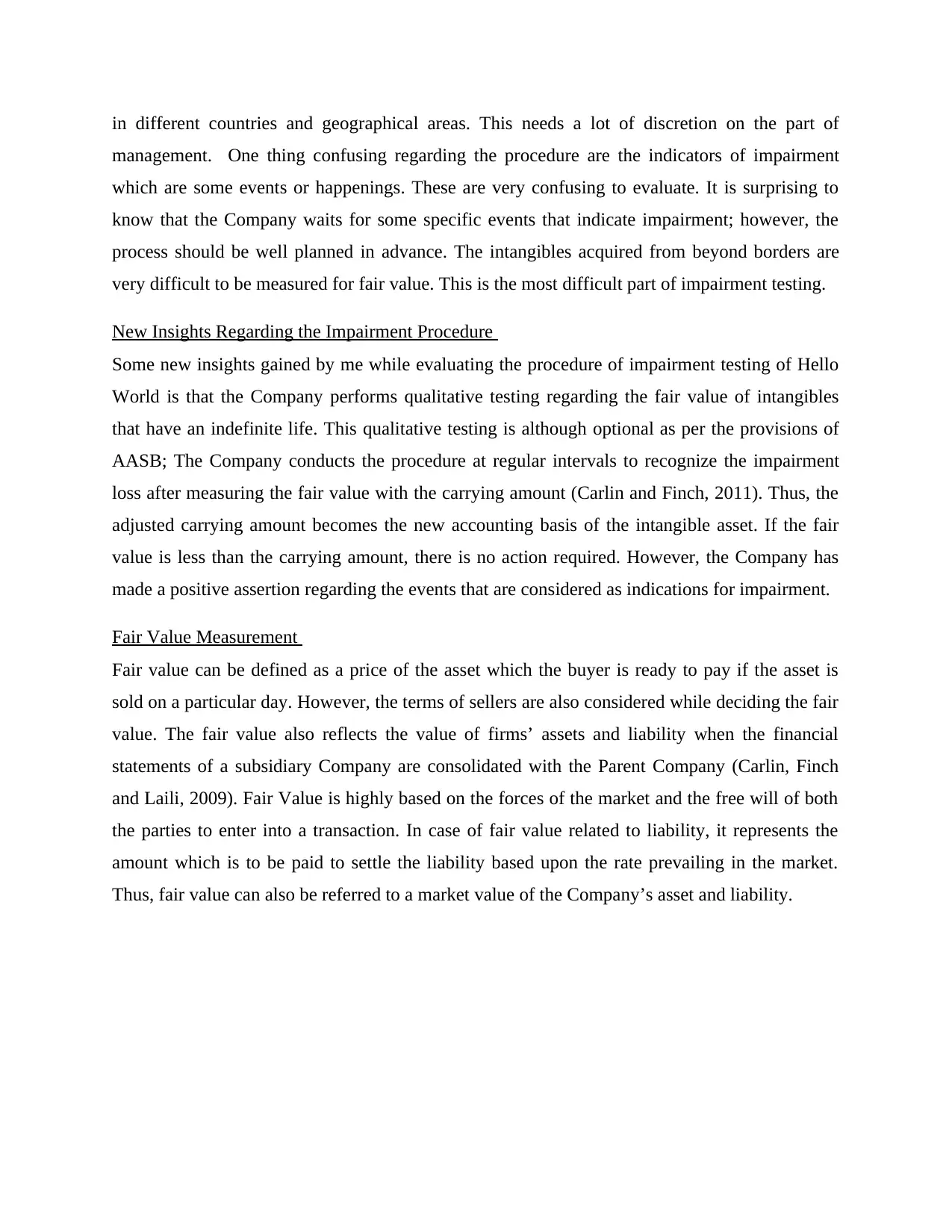
in different countries and geographical areas. This needs a lot of discretion on the part of
management. One thing confusing regarding the procedure are the indicators of impairment
which are some events or happenings. These are very confusing to evaluate. It is surprising to
know that the Company waits for some specific events that indicate impairment; however, the
process should be well planned in advance. The intangibles acquired from beyond borders are
very difficult to be measured for fair value. This is the most difficult part of impairment testing.
New Insights Regarding the Impairment Procedure
Some new insights gained by me while evaluating the procedure of impairment testing of Hello
World is that the Company performs qualitative testing regarding the fair value of intangibles
that have an indefinite life. This qualitative testing is although optional as per the provisions of
AASB; The Company conducts the procedure at regular intervals to recognize the impairment
loss after measuring the fair value with the carrying amount (Carlin and Finch, 2011). Thus, the
adjusted carrying amount becomes the new accounting basis of the intangible asset. If the fair
value is less than the carrying amount, there is no action required. However, the Company has
made a positive assertion regarding the events that are considered as indications for impairment.
Fair Value Measurement
Fair value can be defined as a price of the asset which the buyer is ready to pay if the asset is
sold on a particular day. However, the terms of sellers are also considered while deciding the fair
value. The fair value also reflects the value of firms’ assets and liability when the financial
statements of a subsidiary Company are consolidated with the Parent Company (Carlin, Finch
and Laili, 2009). Fair Value is highly based on the forces of the market and the free will of both
the parties to enter into a transaction. In case of fair value related to liability, it represents the
amount which is to be paid to settle the liability based upon the rate prevailing in the market.
Thus, fair value can also be referred to a market value of the Company’s asset and liability.
management. One thing confusing regarding the procedure are the indicators of impairment
which are some events or happenings. These are very confusing to evaluate. It is surprising to
know that the Company waits for some specific events that indicate impairment; however, the
process should be well planned in advance. The intangibles acquired from beyond borders are
very difficult to be measured for fair value. This is the most difficult part of impairment testing.
New Insights Regarding the Impairment Procedure
Some new insights gained by me while evaluating the procedure of impairment testing of Hello
World is that the Company performs qualitative testing regarding the fair value of intangibles
that have an indefinite life. This qualitative testing is although optional as per the provisions of
AASB; The Company conducts the procedure at regular intervals to recognize the impairment
loss after measuring the fair value with the carrying amount (Carlin and Finch, 2011). Thus, the
adjusted carrying amount becomes the new accounting basis of the intangible asset. If the fair
value is less than the carrying amount, there is no action required. However, the Company has
made a positive assertion regarding the events that are considered as indications for impairment.
Fair Value Measurement
Fair value can be defined as a price of the asset which the buyer is ready to pay if the asset is
sold on a particular day. However, the terms of sellers are also considered while deciding the fair
value. The fair value also reflects the value of firms’ assets and liability when the financial
statements of a subsidiary Company are consolidated with the Parent Company (Carlin, Finch
and Laili, 2009). Fair Value is highly based on the forces of the market and the free will of both
the parties to enter into a transaction. In case of fair value related to liability, it represents the
amount which is to be paid to settle the liability based upon the rate prevailing in the market.
Thus, fair value can also be referred to a market value of the Company’s asset and liability.
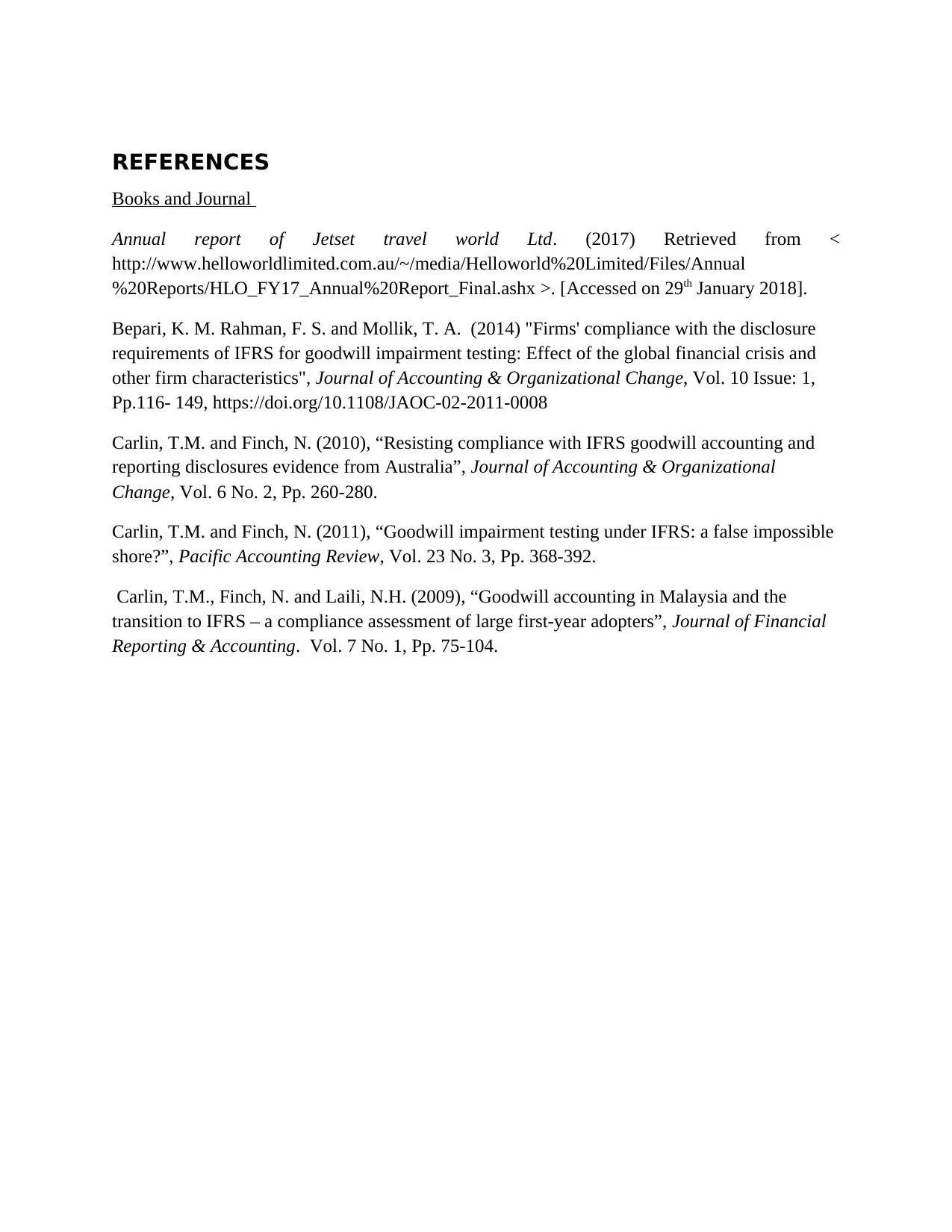
REFERENCES
Books and Journal
Annual report of Jetset travel world Ltd. (2017) Retrieved from <
http://www.helloworldlimited.com.au/~/media/Helloworld%20Limited/Files/Annual
%20Reports/HLO_FY17_Annual%20Report_Final.ashx >. [Accessed on 29th January 2018].
Bepari, K. M. Rahman, F. S. and Mollik, T. A. (2014) "Firms' compliance with the disclosure
requirements of IFRS for goodwill impairment testing: Effect of the global financial crisis and
other firm characteristics", Journal of Accounting & Organizational Change, Vol. 10 Issue: 1,
Pp.116- 149, https://doi.org/10.1108/JAOC-02-2011-0008
Carlin, T.M. and Finch, N. (2010), “Resisting compliance with IFRS goodwill accounting and
reporting disclosures evidence from Australia”, Journal of Accounting & Organizational
Change, Vol. 6 No. 2, Pp. 260-280.
Carlin, T.M. and Finch, N. (2011), “Goodwill impairment testing under IFRS: a false impossible
shore?”, Pacific Accounting Review, Vol. 23 No. 3, Pp. 368-392.
Carlin, T.M., Finch, N. and Laili, N.H. (2009), “Goodwill accounting in Malaysia and the
transition to IFRS – a compliance assessment of large first-year adopters”, Journal of Financial
Reporting & Accounting. Vol. 7 No. 1, Pp. 75-104.
Books and Journal
Annual report of Jetset travel world Ltd. (2017) Retrieved from <
http://www.helloworldlimited.com.au/~/media/Helloworld%20Limited/Files/Annual
%20Reports/HLO_FY17_Annual%20Report_Final.ashx >. [Accessed on 29th January 2018].
Bepari, K. M. Rahman, F. S. and Mollik, T. A. (2014) "Firms' compliance with the disclosure
requirements of IFRS for goodwill impairment testing: Effect of the global financial crisis and
other firm characteristics", Journal of Accounting & Organizational Change, Vol. 10 Issue: 1,
Pp.116- 149, https://doi.org/10.1108/JAOC-02-2011-0008
Carlin, T.M. and Finch, N. (2010), “Resisting compliance with IFRS goodwill accounting and
reporting disclosures evidence from Australia”, Journal of Accounting & Organizational
Change, Vol. 6 No. 2, Pp. 260-280.
Carlin, T.M. and Finch, N. (2011), “Goodwill impairment testing under IFRS: a false impossible
shore?”, Pacific Accounting Review, Vol. 23 No. 3, Pp. 368-392.
Carlin, T.M., Finch, N. and Laili, N.H. (2009), “Goodwill accounting in Malaysia and the
transition to IFRS – a compliance assessment of large first-year adopters”, Journal of Financial
Reporting & Accounting. Vol. 7 No. 1, Pp. 75-104.
⊘ This is a preview!⊘
Do you want full access?
Subscribe today to unlock all pages.

Trusted by 1+ million students worldwide
1 out of 6
Related Documents
Your All-in-One AI-Powered Toolkit for Academic Success.
+13062052269
info@desklib.com
Available 24*7 on WhatsApp / Email
![[object Object]](/_next/static/media/star-bottom.7253800d.svg)
Unlock your academic potential
Copyright © 2020–2025 A2Z Services. All Rights Reserved. Developed and managed by ZUCOL.





